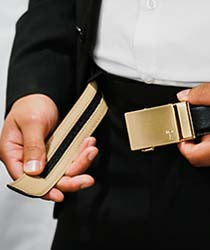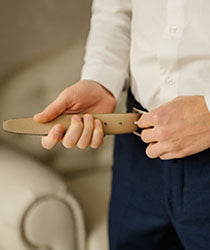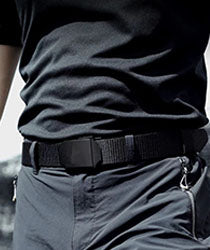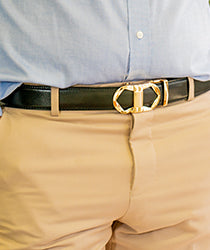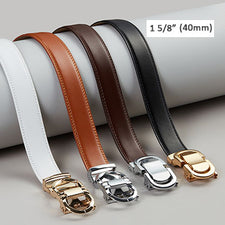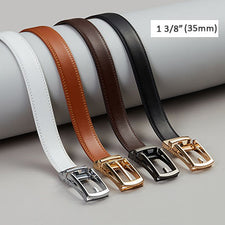A tie is a perfect way to add a little extra flair to an outfit. It can be worn casually with a button-down dress shirt and jeans, or wearing a suit—and everything in between! One of the most common questions is: What is the proper tie length?
Well, we're here to answer that question for you today, so keep reading to find out how long your tie should actually be!
How long should a tie be?
A well-tied tie should sit in the middle of your waist, with the tip of the tie pointing downwards. The proper tie length is when it just about reaches the bottom of your waistband or belt line.
However, some people prefer their ties to be shorter or longer than this. If you can see the shirt fabric between the top of your belt and your tie, it is considered short. On the other hand, if the tie extends beyond the width of your belt, then it is considered long.
There are no hard and fast rules regarding the correct tie length should be – ultimately, it is up to personal preference. However, following these guidelines will ensure that you look smart and stylish!
Tie lengths- Throughout history!
The length of a tie has been an important factor in its style and the message it sends. In different cultures and eras, ties have been worn at varying lengths. Here is a look at the history of tie length, from long to short!
In ancient China, Korea, and Japan, nobility wore long silk robes often tied with sashes or cords at the waist. The upper class also donned longer tunics during this period. This style was adopted by European royalty in the Middle Ages as well; men would wear knee-length tunics called houppelandes that were belted at the waist and could be fastened with a cord or ribbon.
Tie lengths began to vary more in fashion during the Renaissance when neckwear became decorative rather than functional. At around this time, ties first appeared in paintings (such as those by Hans Holbein), indicating their growing popularity among Europe's elite classes. However, these early ties were much shorter than ones worn today – they typically reached only halfway down the chest before ending in a small bow or knot just above the stomach!
As fashions changed throughout subsequent centuries, so did tie lengths; they got longer again during Georgian times before shrinking back down to Victorian levels (just below Adam's apple).
It wasn't until after World War I that modern-day tie lengths came into vogue, thanks to trends set by celebrities like Rudolph Valentino and Douglas Fairbanks Sr., who popularized what we now know as the proper tie length!
How do you determine the proper tie length?
There's nothing worse than a tie that's too short or too long. But how can you be sure to get the perfect length every time? Here are a few tips!
- Measure from the center of your collarbone to the middle of your belt buckle (or wherever you want the end of your tie to fall). This is generally considered a proper tie length, but it may be slightly different for you, depending on your height and build.
- Another way to measure is from the top of your shoulder down to where you want the bottom of your tie to hit. Again, this will vary based on personal preference and proportions.
- If in doubt, err on the side of caution and go with a longer tie- you can always shorten it if need be, but it's much harder to lengthen a tie should it prove too short.

Proper tie length to height
-
For a tall man
For a tall man, the ideal tie length is 60-63 inches. This allows the tie to hit at just the right spot on your chest and ensures that it will hang properly without being too short or too long.
If you fall outside of this range, don't worry - there are still ways to find a tie that fits well. Just be sure to keep proportions in mind when shopping for ties so that you end up with one that looks great!
-
And if you are short?
A proper tie length for a person of short stature is 57 inches. This will ensure that the tie does not protrude too far below the belt line and give the illusion of shorter stature.
A good rule of thumb is to have the tie come down to about halfway between your navel and your sternum!
How do knots affect tie length?
When it comes to choosing the proper tie length, knots can have a big impact. The size and type of the knot will determine how much excess fabric is left at the end of your tie.
This means if you want a shorter tie, go for a smaller knot (such as the four-in-hand). A larger knot (like the full Windsor knot) will leave you with more material to work with, therefore, a longer overall tie.
Of course, there are other factors to consider when selecting tie length, such as your height and build. But knowing which knots affect tying lengths can help give you an idea of what style might suit you best!
Conclusion
There you have it! In a nutshell, we've covered the proper tie length, how to tie it, and how knots affect tie lengths.
Ties are an essential part of any gentleman's wardrobe. They add flair and colour to an outfit and can be used to emphasize or downplay certain parts of your appearance. They're also great for jazzing up your look without completely changing your outfit.
With all this in mind, you must know how long a tie should be when you wear tie so that it doesn't end up looking like a noose around your neck or dragging on the ground behind you!
Ready to dress sharp and command respect with the right accessory? Click here to discover Tonywell, the Professional Accessories Supplier.

